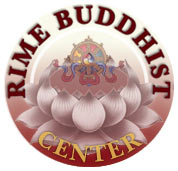The Rime Buddhist Center celebrates transgender awareness week by highlighting Rime sangha member, Circe Namkha Rangdrol, she/her/hers. Lama Matt asked Circe to share about her experience with coming out as transgender and how being a Buddhist has helped her along the way.
As Buddhist experiences go, and as transgender experiences go, I can only speak for myself.
When I first realized I was a transgender woman, I was confused and frightened and anxious. I felt profoundly vulnerable, and had no examples among Buddhist teachers or teachings that I knew of that could help me make sense of it all. I struggled with many questions, including how can I reconcile my insistence on this truer self with the teachings on no-self? I had no understanding of how to bring this onto the spiritual path.
I felt a kind of double whammy, that Buddhism taught I had no self, and that society argued I didn’t have a real gender. In today’s society, transgender people constantly have to defend and negotiate the validity of their identities, their identities are seemingly up for debate by those who don’t struggle with gender and their lived experiences are not listened to. I felt that there was a deep way in which I would have to forego finally feeling comfortable in my gender in order to practice the Dharma. Or I would have to give up the Dharma in order to finally feel comfortable in my gender. I had an intuition though that these things could be reconciled. It is an ongoing process.
I had to realize that everyone’s identities arise due to various causes and conditions. This doesn’t mean that they don’t exist. Just that they are temporary. We still have to engage with what arises. Gender identities arise in relation to the experience of the genders of others, and how they interact with various genders both one’s own and others, and how this reflects back onto one’s own body. In other words, it arises due to the unique mix of biological diversity, social interactions, and cultural context that we each distinctly and individually experience. It arises, and we can use what arises to bring us closer to the liberation that the Dharma teaches. This is a kind of skillful means. This is the beginning of the way that I was able to contextualize my gender identity within the Dharma.
My understanding of myself as transgender actually came about due to my Buddhist practice. I’d known that I was more-or-less gender variant for quite a while, but it was through a Dharmic practice of exploring my fears and engaging with them that I came to realize that I am a transgender woman. It was from this realization that I was able to see modes of suffering–gender dysphoria, the anxiety around my femininity being exposed, the fear of homophobic or transphobic violence–that had been with me my entire life, but that I had suppressed and wasn’t even consciously aware of. Once I was made aware of this suffering could I then start the work of addressing it. This work, the work of the Dharma, has given me a measure of fearlessness, has given me a way to become more naturally myself and more naturally in the world. And, for me, being out and visible as a trans person is also part of my Bodhisattva commitment; just as when I was confused and closeted, and gained confidence when I saw trans people owning their transness and living fiercely in the world, so too may my visibility as a trans woman grant fearlessness to those who remain in the closet.
– Circe Namkha Rangdrol, she/her/hers


